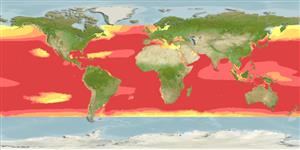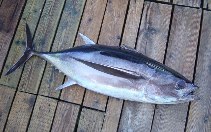個人による観察記録の追加 Fish Watcher
| Native range | All suitable habitat | Point map | Year 2050 |

|
| This map was computer-generated and has not yet been reviewed. |
| Thunnus alalunga AquaMaps Data sources: GBIF OBIS |
Upload your 写真 and ビデオ
Pictures | Videos | Stamps, coins, misc. | グーグルの画像Thunnus alalunga
Picture by Archambault, C.
Pictures | Videos | Stamps, coins, misc. | グーグルの画像Thunnus alalunga
Picture by Archambault, C.
India country information
Common names:
Albacore
Occurrence: native
Salinity: marine
Abundance: | Ref:
Importance: | Ref:
Aquaculture: | Ref:
Regulations: | Ref:
Uses: no uses
Comments:
National Checklist:
Country Information: https://www.cia.gov/library/publications/resources/the-world-factbook/geos/in.html
National Fisheries Authority:
Occurrences: Occurrences Point map
Main Ref: Kapoor, D., R. Dayal and A.G. Ponniah, 2002
National Database:
Occurrence: native
Salinity: marine
Abundance: | Ref:
Importance: | Ref:
Aquaculture: | Ref:
Regulations: | Ref:
Uses: no uses
Comments:
National Checklist:
Country Information: https://www.cia.gov/library/publications/resources/the-world-factbook/geos/in.html
National Fisheries Authority:
Occurrences: Occurrences Point map
Main Ref: Kapoor, D., R. Dayal and A.G. Ponniah, 2002
National Database:
Common names from other countries
分類 / Names 共通名の | 類義語 | Catalog of Fishes(部類, 種) | ITIS | CoL | WoRMS | Cloffa
> Scombriformes (Mackerels) > Scombridae (Mackerels, tunas, bonitos) > Scombrinae
Etymology: Thunnus: Greek, thynnos = tunna (Ref. 45335).
More on author: Bonnaterre.
Etymology: Thunnus: Greek, thynnos = tunna (Ref. 45335).
More on author: Bonnaterre.
Environment: milieu / climate zone / depth range / distribution range 生態学
海; 海洋回遊性 (Ref. 51243); 深さの範囲 0 - 600 m (Ref. 168). Subtropical; 10°C - 25°C (Ref. 168); 60°N - 50°S, 180°W - 180°E
分布 国々 | 国連食糧農業機関の区域 | エコシステム | 事件 | Point map | 導入 | Faunafri
Cosmopolitan in tropical and temperate waters of all oceans including the Mediterranean Sea but not at the surface between 10°N and 10°S. Western Pacific: range extend in a broad band between 40°N and 40°S (Ref. 9684). Often confused with juvenile Thunnus obesus which also have very long pectorals but with rounded tips. Highly migratory species.
Length at first maturity / サイズ / 重さ / 年齢
Maturity: Lm 85.2, range 83 - ? cm
Max length : 140 cm FL オス/雌雄の選別がない; (Ref. 3669); common length : 100.0 cm FL オス/雌雄の選別がない; (Ref. 9684); 最大公表体重: 60.3 kg (Ref. 40637); 最大記録サイズ: 9 年 (Ref. 72462)
Max length : 140 cm FL オス/雌雄の選別がない; (Ref. 3669); common length : 100.0 cm FL オス/雌雄の選別がない; (Ref. 9684); 最大公表体重: 60.3 kg (Ref. 40637); 最大記録サイズ: 9 年 (Ref. 72462)
簡単な記述 検索表 | 形態学 | 形態計測学
背面の脊椎 (合計) : 11 - 14; 背鰭 (合計) : 12 - 16; 肛門の骨: 0; 臀鰭: 11 - 16. Anterior spines much higher than posterior spines giving the fin a strongly concave outline. Interpelvic process small and bifid. Body with very small scales. Pectoral fins remarkably long, about 30% of fork length or longer in 50 cm or longer fish. Ventral surface of liver striated and the central lobe is largest.
An epipelagic and mesopelagic, oceanic species, abundant in surface waters of 15.6° to 19.4°C; deeper swimming, large albacore are found in waters of 13.5° to 25.2°C; temperatures as low as 9.5°C may be tolerated for short periods (Ref. 168). Known to concentrate along thermal discontinuities (Ref. 168). Form mixed schools with skipjack tuna (Katsuwonus pelamis), yellowfin tuna (Thunnus albacares) and bluefin tuna (T. maccoyii), schools may be associated with floating objects, including sargassum weeds (Ref. 168). Feed on fishes, crustaceans and squids. Eggs and larvae are pelagic (Ref. 6769). Sexual maturity reached at 90 cm (Ref. 36731). Highly appreciated and marketed fresh, smoked, deep frozen or canned. Eaten steamed, broiled, fried and microwaved (Ref. 9987). Also Ref. 1762, 1798, 1804.
Angling: Largely caught offshore, where the waters are mild and blue. Albacore favor those areas where cooler water interfaces with warmer water. They are caught with live of dead baitfish such as mullet, sauries, squid, herring, anchovies, sardines, and other small fish. Albacore strike hard and make powerful runs (Ref. 84357).
Life cycle and mating behavior 成熟 | 繁殖 | 放精 | 卵 | 生産力 | 幼生
The sex ratio in catches is about 1:1 for immature individuals, but males predominate among mature fishes, which is possibly due to both differential mortality of sexes and differential growth rate after maturity.
主な参考文献
Upload your references | 参考文献 | コーディネーター : Collette, Bruce B. | 協力者
Collette, B.B. and C.E. Nauen, 1983. FAO Species Catalogue. Vol. 2. Scombrids of the world. An annotated and illustrated catalogue of tunas, mackerels, bonitos and related species known to date. Rome: FAO. FAO Fish. Synop. 125(2):137 p. (Ref. 168)
人間に対する脅威
Harmless
Human uses
水産業: 高い商業の; ゲームフィッシュ: はい
FAO(水産業: 代謝, 種の外形; publication : search) | FIRMS (Stock assessments) | FishSource | 私達の周りの海
より多くの情報
Population dynamics
成長のパラメーター
Max. ages / sizes
Length-weight rel.
Length-length rel.
体長組成
Mass conversion
補充
豊度
成長のパラメーター
Max. ages / sizes
Length-weight rel.
Length-length rel.
体長組成
Mass conversion
補充
豊度
Physiology
Body composition
Nutrients
酸素消費
水泳形態
泳ぐ速さ
Visual pigments
Fish sound
Diseases & Parasites
Toxicity (LC50s)
Body composition
Nutrients
酸素消費
水泳形態
泳ぐ速さ
Visual pigments
Fish sound
Diseases & Parasites
Toxicity (LC50s)
用具
E-book | 野外観察図鑑 | 検索表 | Length-frequency wizard | 生活史の基盤ツール | 目的のマップ | Classification Tree
| Catch-MSY |
特記事項
XMLをダウンロードして下さい
インターネットの情報源
Aquatic Commons | BHL | Cloffa | BOLDSystems | Websites from users | Check FishWatcher | CISTI | Catalog of Fishes(部類, 種) | DiscoverLife | ECOTOX | Faunafri | Fishtrace | GenBank(ゲノム, ヌクレオチド) | GloBI | GOBASE | | Google Books | Google Scholar | Google | IGFA World Record | MitoFish | 国のデーターベース | Otolith Atlas of Taiwan Fishes | PubMed | Reef Life Survey | RFE Identification | Scirus | SeaLifeBase | 生命の木 | Wikipedia(行く, 検索する) | World Records Freshwater Fishing | 動物に関する記録
Estimates based on models
Preferred temperature (Ref. 115969): 8.8 - 21.2, mean 15.1 (based on 784 cells).
Phylogenetic diversity index (Ref. 82804): PD50 = 0.5039 [Uniqueness, from 0.5 = low to 2.0 = high].
Bayesian length-weight: a=0.01698 (0.01397 - 0.02064), b=3.01 (2.98 - 3.04), in cm Total Length, based on LWR estimates for this species (Ref. 93245).
栄養段階 (Ref. 69278): 4.3 ±0.2 se; based on diet studies.
回復力 (Ref. 120179): 手段, 1.4年~4.4年の倍増期間の最小個体群 (K=0.13-0.18; tm=4-6; tmax=10; Fec=2 million).
Prior r = 0.43, 95% CL = 0.28 - 0.64, Based on 15 full stock assessments.
Fishing Vulnerability (Ref. 59153): High to very high vulnerability (71 of 100).
Climate Vulnerability (Ref. 125649): Moderate vulnerability (42 of 100).




